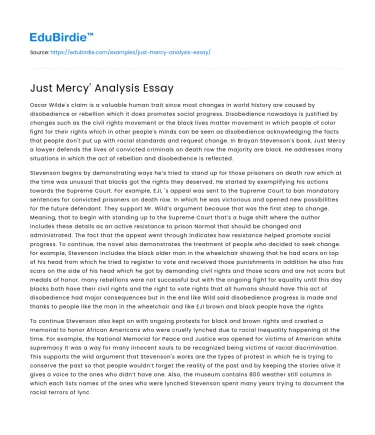Introduction
In "Just Mercy," Bryan Stevenson delineates the intricate and often inequitable landscape of the American criminal justice system. Through a poignant narrative that intertwines real-life cases with the overarching themes of racial injustice, systemic bias, and the pursuit of mercy, Stevenson offers an unflinching critique of a system that frequently fails those it is meant to protect. The memoir, grounded in Stevenson's experiences as a lawyer and founder of the Equal Justice Initiative, not only exposes the deep-seated flaws in the system but also underscores the resilience of the human spirit in the face of overwhelming adversity. By highlighting both individual stories and systemic patterns, Stevenson invites readers to engage critically with the moral and ethical dimensions of justice. This essay seeks to explore the multifaceted arguments presented in "Just Mercy," examining the systemic failures it reveals, the personal stories it shares, and the broader implications for criminal justice reform.
Systemic Failures in the Criminal Justice System
Stevenson’s "Just Mercy" provides a comprehensive examination of systemic failures within the American criminal justice system, particularly its racial and economic biases. One of the most compelling examples is the case of Walter McMillian, a Black man wrongfully convicted of murder and sentenced to death in Alabama. McMillian’s case illustrates the pervasive racial prejudice that taints the legal process, as he was convicted based on scant and fabricated evidence, primarily because of his race. According to Stevenson, "The reality is that people of color are more likely to be wrongfully convicted than white people because of racial bias and discrimination" (Stevenson, 2014).
Save your time!
We can take care of your essay
- Proper editing and formatting
- Free revision, title page, and bibliography
- Flexible prices and money-back guarantee
The book further explores how poverty exacerbates these injustices, as individuals lacking financial resources cannot afford competent legal representation. This often results in disadvantaged defendants being coerced into plea deals or receiving inadequate defense from overworked public defenders. Stevenson argues that the system is designed to punish the poor disproportionately, a sentiment echoed by numerous studies, including one by the Brennan Center for Justice, which highlights the correlation between poverty and higher rates of incarceration (Brennan Center, 2019). By focusing on these systemic issues, Stevenson calls for a reevaluation of policies and practices that perpetuate inequity, advocating for reforms that address the root causes of injustice.
Personal Stories and Their Broader Implications
Beyond systemic critiques, "Just Mercy" humanizes the statistics and data through personal narratives that illustrate the profound impact of the justice system on individuals and communities. Stevenson shares the stories of clients like Herbert Richardson, a Vietnam War veteran with mental health issues, who was executed despite compelling evidence of his mental illness. These stories serve to highlight the moral and ethical failings of a system that prioritizes punishment over rehabilitation, reflecting a broader societal indifference to the plight of marginalized individuals.
Stevenson’s narrative strategy effectively evokes empathy and understanding, urging readers to consider the humanity of those caught in the system's crosshairs. The emotional resonance of these stories challenges prevailing narratives that dehumanize incarcerated individuals, positioning them instead as victims of systemic neglect. This approach aligns with restorative justice principles, which advocate for healing and rehabilitation rather than retribution. By emphasizing personal stories, Stevenson not only critiques the system but also champions a vision of justice that is compassionate and transformative.
Counter-Arguments and the Need for Reform
While Stevenson's arguments are compelling, critics might argue that the book's focus on individual cases could obscure broader systemic issues or suggest that the system is only flawed in isolated instances. However, Stevenson preemptively addresses this counter-argument by linking individual stories to a pattern of systemic abuse and by using data and research to bolster his claims. For instance, the Sentencing Project's reports corroborate Stevenson’s assertion that racial disparities are pervasive and systemic rather than anecdotal (The Sentencing Project, 2018).
Another potential counter-argument is the notion that the criminal justice system is fundamentally just and that wrongful convictions are rare anomalies. However, Stevenson counters this by outlining pervasive issues such as prosecutorial misconduct, inadequate legal representation, and racial bias, which contribute to a higher likelihood of wrongful convictions. His call for reform is not merely an appeal to emotion but a well-reasoned argument for systemic change, grounded in empirical evidence and a deep understanding of legal and social dynamics.
Conclusion
"Just Mercy" serves as both a damning indictment of the American criminal justice system and a powerful call to action for reform. Through the juxtaposition of systemic critique and personal narrative, Stevenson illuminates the urgent need for a justice system that is equitable, humane, and restorative. His work challenges readers to confront uncomfortable truths about racial and economic disparities and to embrace a vision of justice that extends beyond mere punishment. By addressing potential counter-arguments and reinforcing the necessity for reform with empirical evidence, Stevenson strengthens his thesis and underscores the moral imperative for change. Ultimately, "Just Mercy" is not just a book about injustice; it is a clarion call for mercy, compassion, and the reimagining of justice in America.






 Stuck on your essay?
Stuck on your essay?

